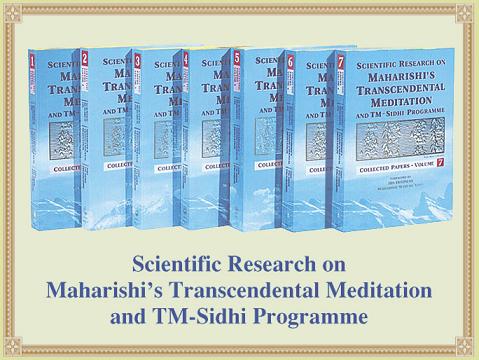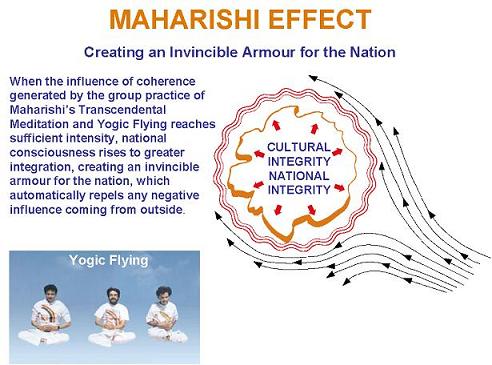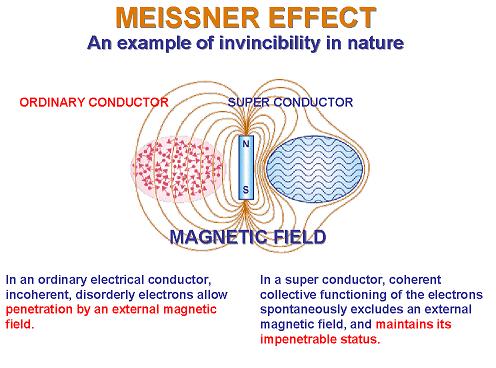invincibleireland.org
Proven Technology to Raise Any Nation to Invincibility
Maintaining an Invincible Influence of Coherence, Integrity, Strength, and Well-Being in the Nation
The scientific research findings summarized in this document establish that the knowledge and practical procedures are now available to secure in any nation a state of all positivity and no negativity reflected in increasing happiness, health, economic vitality, national security, and reduced turbulence and violence in the whole populationin a word, the invincibility of the nation. To establish this effect it is only necessary to maintain a group of individuals trained to create an integrated national consciousness.
Scientifically Validated Programme to Secure National Invincibility
Scientific research has verified the practicality of creating an integrated national consciousness through group practice of the Transcendental Meditation and TM-Sidhi Programme, including Yogic Flying. This technology of consciousness enlivens in collective consciousness the source of all order and progress in naturethe Unified Field of Natural Law.
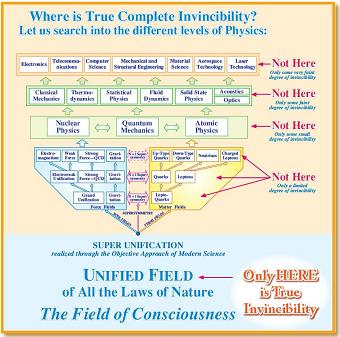
Click to open full-size
Progress of physics during the past 30 years has provided an increasingly unified understanding of the Laws of Nature governing all forces and particles, culminating in the mathematical description of the Unified Field of Natural Law. This discovery confirms that the entire diversity of the ever-expanding universe is the expression of unity at the most fundamental scale of natures functioning.
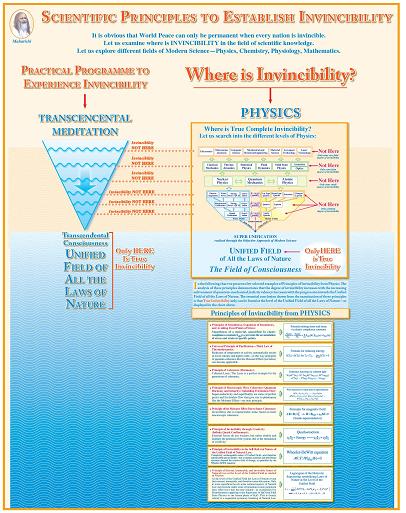
Click to open full-size
This field is open to direct experience as the field of Transcendental Consciousness, through the Transcendental Meditation and TM-Sidhi Program, including Yogic Flying. It is through these technologies of consciousness that the field of Transcendental Consciousness is applied to all areas of individual life and society.
Complete knowledge of the Unified Field as the field of Transcendental Consciousness, and the practical technologies to apply this field of perfect order to national life, are now available in Maharishi's Vedic Science.
Benefits for Individual Life
Benefits at the individual level include the following: increased use of total brain functioning, as indicated by increased EEG coherence (ref. 1, back page), greater synchrony of brain functioning, more adaptive and flexible brain functioning, and mobilization of the latent reserves of the brain (2);
increased intelligence, clarity of mind, and creativity (3);
improved perception and mind-body coordination (4);
improved health, less illness, and reduced health care costs (5);
more healthy behaviour (6);
improved mental healthdecreased anxiety, decreased depression, improved well-being (7);
improved job performance and increased productivity (8);
improved relationships at home and at work (9).
Benefits for the Whole Society
Most relevant to the creation of national invincibility are the many research studies documenting the effect of increased coherence in the whole society created by sufficiently large groups of participants in the Transcendental Meditation and TM-Sidhi Programme, including Yogic Flying.The positive influence of increased coherence and invincibility in society has been measured in terms of:
reduction of crime and violence in society
improved economic conditions
improved social trends
using the most rigourous scientific methods.
The Formula
These research studies confirm the formula that a single group of individuals numbering at least the square root of one per cent of the population of the nation, participating in the twice-daily group practice of these technologies, is sufficient to generate an influence of integrity, harmony, strength, and increased vitality in the whole national consciousnessthe growth of national invincibility.The required size of the group of Yogic Flyers is extremely small in the light of its far-reaching effects, and thus is very practical to achieve.
For example:
a country of 16 million citizens will require a group of only 400 experts in the TM-Sidhi Programme
a nation of 64 million people will require a group of only 800 experts.
Such groups can be created even by incorporating this programme in the schools, so that the nation is growing in integration as the students are growing in the individual benefits noted above.
The Maharishi Effect
The influence of coherence in society created by a group of TM-Sidhi Yogic Flyers is known in the scientific literature as the Maharishi Effect. The Maharishi Effect in society is parallel to the Meissner Effect of physics, in which a highly coherent physical system maintains its internal integrity and repels potentially disruptive outside influences.Scientific Research Findings
The following sections list the scientific research findings at the city, state, national, and international levels during the specific time periods when large groups of coherence creating experts practicing the TM and the TM-Sidhi Programme including Yogic Flying have been established.
Improved Quality of City Life
Decreased Crime and Decreased Crime Rate (10)
Decreased Violent Crime and Decreased Homicides (11)
Decreased Automobile Accidents (12)
Decreased Emergency Psychiatric Calls (13)
Decreased Hospital Trauma Visits (13)
Decreased Police Complaints (13)
Improved Quality of City Life as Measured by an Index Comprising Data on Fires, Automobile Accidents, and Crime (12)
Improved Quality of Provincial Life
Decreased Crime (14, 15)
Decreased Traffic Fatalities (15)
Decreased Unemployment (15)
Improvement on an Overall Index Including Total Crime Rate, Mortality Rate, Motor Vehicle Fatality Rate, Auto Accident Rate, Unemployment Rate, Pollution, Alcoholic Beverage Consumption Rate, and Cigarette Consumption Rate (14)
Improved Quality of National Life*
Decreased Crime (12)
Decreased Number of Fatalities from Suicide, Homicide, Accidents (16)
Improved National Economy as Measured by Reduced Inflation and Unemployment (17)
Increased International Economic Competitiveness (18)
Stable Growth of Balanced Economic Health (18)
Increased National Confidence, Optimism, and Economic Prosperity as Measured by Improvement in Stock Market Index (12)
Improved Quality of National Life as Measured by an Index Comprising Data on Crime, the National Stock Market, and National Mood (12)
Improvement on an Index of Motor Vehicle Fatalities, Homicides, and Suicides (16, 19)
Improvement on an Overall Index Including Motor Vehicle Fatalities, Homicide, and Suicide, Cigarette Consumption, Worker-Days Lost in Strikes (19)
Improvement on an Overall Index Including Motor Vehicle Fatalities, Homicide, Suicide, Deaths Due to Accidents (other than Motor Vehicle), Notifiable Diseases, Alcohol Consumption, Cigarette Consumption (20)
*In addition to the findings listed here, which are the results of research conducted over the past decades, the most recent results at the national level have been found in The Netherlands, where an influence of invincibility has been created by a group of 400 Yogic Flyers etablished on 12 April 2006. Positive national economic changes reported by the press during the following weeks included reduced unemployment, increased job creation, increased business and consumer confidence, record stock exchange transactions, and unexpectedly positive economic projections. Positive social trends included greater government consensus and decisiveness in introducing and approving policies that are beneficial to businesses, to the economic welfare and health of citizens, to developing sustainable energy sources, and to maintaining cultural integrity.
Improved Quality of International Life
Reduced International Conflict (21)
Reduced Fatalities and Injuries Due to International Terrorism (21)
Decreased War Intensity and Deaths (22)
Increased Progress toward Peaceful Resolution of Conflict (22)
Increased Harmony in International Relations (23)
Research References
(1) International Journal of Neuroscience 14: 147151, 1981; Psychosomatic Medicine 46: 267276, 1984; International Journal of Neuroscience 54: 112, 1990.
(2) Psychophysiology 26: 529 (Abstract), 1989; Human Physiology 25: 171180, 1999; Pflόgers Archiv 359 (Suppl.): 191, R 96 (Abstract), 1975; Zeitschrift fόr Elektroenzephalographie und Elektromyographie EEG-EMG 7: 99103, 1976; International Journal of Neuroscience 10: 165170, 1980; Psychophysiology 27 (Suppl.): 4A (Abstract), 1990; Psychophysiology 31: S67 (Abstract), 1994; Psychophysiology 14: 293296, 1977; Biological Psychology 55: 4155, 2000; Biological Psychology 61: 293319, 2002; Signal Processing 85: 22132232, 2005.
(3) Gedrag: Tijdschrift voor Psychologie 3: 167182, 1975; Dissertation Abstracts International 38(7): 3372B3373B, 1978; College Student Journal 15: 140146, 1981; Perceptual and Motor Skills 62: 731738, 1986; The Journal of Creative Behavior 19: 270275, 1985; Journal of Clinical Psychology 42: 161164, 1986; Personality and Individual Differences 12: 11051116, 1991; International Journal of Neuroscience 15: 151157, 1981; Journal of Personality and Social Psychology 57: 950964, 1989.
(4) Memory & Cognition 10: 207215, 1982; LEncιphale 10: 139144, 1984; Perceptual and Motor Skills 38: 12631268, 1974; Perceptual and Motor Skills 46: 726, 1978; Journal of Clinical Psychology 42: 161164, 1986.
(5) Psychosomatic Medicine 49: 493507, 1987; American Journal of Health Promotion 10: 208216, 1996.
(6) Anxiety, Stress and Coping 6: 245262, 1993; Alcoholism Treatment Quarterly 11: 1387, 1994.
(7) Journal of Clinical Psychology 45: 957974, 1989; Journal of Counseling and Development 64: 212215, 1985; Journal of Personality and Social Psychology 57: 950964, 1989.
(8) Academy of Management Journal 17: 362368, 1974; Anxiety, Stress and Coping 6: 245262, 1993.
(9) Anxiety, Stress and Coping 6: 245262, 1993; Zeitschrift fόr klinische Psychologie 7: 235255, 1978; Dissertation Abstracts International 38(8): 3895B, 1978.
(10) Journal of Conflict Resolution 32: 776812, 1988; Journal of Crime and Justice 4: 2545, 1981; The Journal of Mind and Behavior 8: 67104, 1987; The Journal of Mind and Behavior 9: 457486, 1988; Psychology, Crime, and Law 2: 165174, 1996.
(11) The Journal of Mind and Behavior 9: 457486, 1988; Social Indicators Research 47: 153201, 1999.
(12) Journal of Conflict Resolution 32: 776812, 1988.
(13) Social Indicators Research 47: 153201, 1999.
(14) The Journal of Mind and Behavior 8: 67104, 1987; Dissertation Abstracts International 51(12): 1991.
(15) Dissertation Abstracts International 51(12): 1991.
(16) Social Indicators Research 22: 399418, 1990.
(17) Proceedings of the American Statistical Association, Business and Economics Statistics Section: 799804, 1987; 491496, 1988; 565570, 1989.
(18) Dissertation Abstracts International 61(4): 2271B, 2000.
(19) Psychological Reports 76: 11711193, 1995.
(20) American Statistical Association, 1996 Proceedings of the Social Statistics Section, pp. 3843.
(21) Journal of Offender Rehabilitation 36: 283302, 2003.
(22) Journal of Social Behavior and Personality 17: 285338, 2005.
(23) Social Science Perspectives Journal 2(4): 8094, 1988; Proceedings of the American Statistical Association, Social Science Statistics Section: 297302, 1990.
